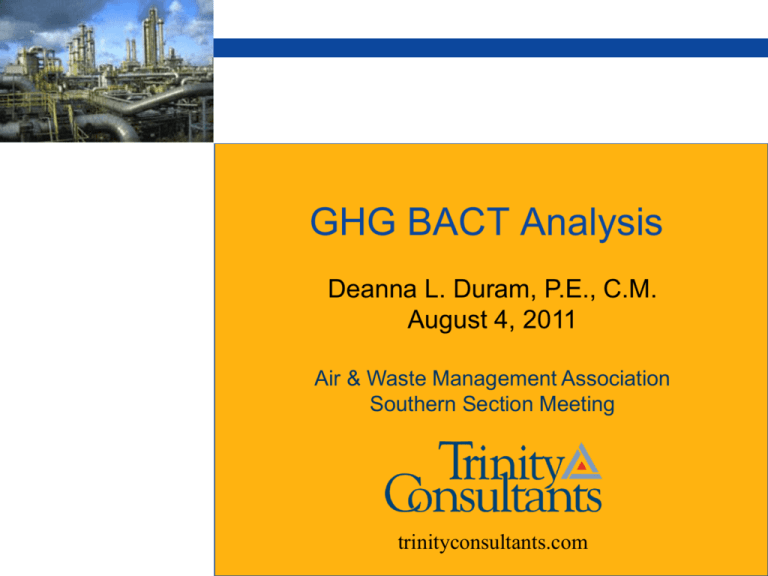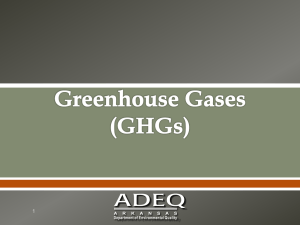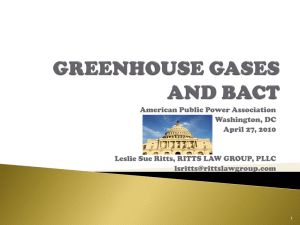Prevention of Significant Deterioration (PSD) Short Course
advertisement

GHG BACT Analysis Deanna L. Duram, P.E., C.M. August 4, 2011 Air & Waste Management Association Southern Section Meeting trinityconsultants.com Outline EPA Guidance and 5-Step Process Differences from traditional BACT approach Highlight a biomass case study throughout EPA BACT Guidance Case-by-case determination Performed by applicant; approved by agency EPA recommends 5-Step top-down BACT evaluation process Emission limits achievable considering… Economic impacts Environmental and energy impacts EPA guidance materials PSD and Title V Permitting Guidance for GHGs White Papers on GHG Control Measures On-Demand Video Training Materials, including sample BACT assessments Enhanced RBLC 5-Step Top-Down BACT Process Step 0 – Define the Source Step 1 – Identify available control options Step 2 – Eliminate technically infeasible options Step 3 – Rank options by control effectiveness Step 4 – Evaluate most effective controls and emission limits achievable Step 5 – Select BACT Step 0 – Define the Source Applicant defines goals, objectives, purpose, and basic design Source definition generally provides key design elements that are not under consideration through the BACT process Define in permit application Permit issuer must discern which design elements are inherent to that purpose and objectives and which may be changed for pollutant reductions Step 0 Case Study New Combined Heat and Power System at existing pulp and paper mill 620 MMBtu/hr bubbling fluidized bed boiler 40 MW Steam turbine generator Biomass combustion (bark, mill residuals) Natural gas for startup burners and some load burning, < 250 MMBtu/hr Installation allows for shutdown of 1 coal/oil/gas power boiler; removal of coal/oil from a second power boiler, retaining only gas combustion Objective is to generate renewable energy to replace fossil fuel energy on site and for potential sale to the utility grid Step 1: Identify Available Control Options (1/2) Identify all control technologies available to the source, including: Inherently lower-emitting processes and designs Add-on technologies Control methods applied at similar emissions sources Feasible combinations of these technologies Considers facility-level impacts No off-site impacts considered, technology must represent emissions reduction at facility Step 1: Identify Available Control Options (2/2) Not required to include options that “fundamentally redefine the nature of the source” No clear guidance re: which technologies redefine nature of source Fuel type as BACT? EPA guidance considers: Cleaner versions of primary fuel Increased usage of secondary fuel Alternative fuel for which source is not already configured EPA guidance leaves door open for stricter interpretations by permitting authority Use relevant white papers as starting point Step 1 Biofuel Considerations EPA Guidance Potential carbon neutrality (based on life-cycle of biofuel) not considered At facility-level, CO2 emissions from biofuels similar to fossil fuels Biofuels must represent emissions reduction at facility level to be considered viable GHG BACT option Biogenic carbon deferral 3/21/2011: EPA proposes deferral of GHG permitting requirements for CO2 emissions from biogenic sources EPA issued guidance for determining BACT for bioenergy production Promulgated 7/20/2011 Effective immediately for delegated states SIP approved states may incorporate into rules Step 1 Energy Efficiency Considerations (1/2) EPA BACT guidance stresses importance of energy efficiency Construction of new facilities Primary Step 1 option(s) for combustion sources GHG BACT evaluated on facility-wide basis, including energy efficiency Evaluate emissions from non-emitting, energy consuming equipment Modification to existing facilities BACT applies to new or modified emission unit, not necessarily to energy consuming equipment EPA guidance still encourages permitting agencies to consider energy efficiency Step 1 Energy Efficiency Considerations (2/2) EPA guidance recommends benchmarking evaluation Collectively assess small energy saving measures by benchmarking efficiency of new unit of similar design EPA resources to support benchmarking analyses ENERGY STAR program Sector-specific tools, Energy Performance Indicators (EPIs), etc. Step 1 CCS Considerations Carbon Capture and Storage (CCS) One of primary distinctions between traditional BACT and GHG BACT Per EPA, consider CCS in Step 1 for large CO2 emitters, sources emitting high-purity CO2 streams Hydrogen production Ammonia production Natural gas processing Ethanol production Ethylene oxide production Cement production Iron and steel manufacturing Even if non high-purity CO2 stream, may need to include as a “possible” control option Step 1 Case Study CCS Efficient Boiler Design Technology selection of BFB boiler over other designs Redefining source? Lowest Carbon Fuel High-purity stream? Not on EPA list Limited industrial applications Consideration of back-up fuels as primary (natural gas) Source redefining concerns – not evaluating any other fuel possibilities Energy Efficiency Options Number of options in EPA guidance documents New boiler – state of the art Step 2: Eliminate Technically Infeasible Options Is technology available? Reached licensing and commercial development stage Compliance with BACT limit demonstrated at similar facility Is technology applicable based on physical, chemical, and engineering principles? Per EPA, absence of a commercial guarantee for GHG emissions not sufficient to eliminate option from consideration Step 2 CCS Considerations Must consider technical feasibility of each step If any step infeasible, CCS considered technically infeasible Capture, transport and storage Low-purity stream? Space Right-of-ways Access to storage reservoir May suffice to demonstrate difference between CCS considerations at applicant’s facility and demonstrated CCS Many state agencies prefer to monetize everything (eliminate from Step 4 instead) Step 2 Case Study CCS Boiler design Addressed supercritical steam design (greater than 3,200 psig operating pressure) as infeasible for this boiler size Fluidized bed, suspension, stoker, and pile combustion feasible options Lowest carbon fuel Low-purity stream? No available storage/pipeline Use of natural gas feasible Efficiency options Feasible Step 3: Rank Remaining Control Options Ranked by effectiveness of control Traditionally presented as: For GHG, EPA advocating efficiencybased control effectiveness Percent pollutant removal Controlled emission rate Reduction in emissions over time Consider thermal efficiency by using emissions per unit of output (rather than per unit of fuel input) Must rank logical combinations of the technologies Can be challenging given variety of iterations on energy efficiencies Step 3 Case Study Compared boiler efficiencies In this case, ranked based on energy efficiency – fluidized bed is the clear choice What if proposing to install a new stoker boiler with a lower energy efficiency? Is this an area an agency can look at – redefining the source? Did not do a straight comparison between remaining options Proceeded to Step 4 with a BFB boiler, and lowest carbon fuel and energy efficiency options to be reviewed Step 4: Evaluate Most Effective Controls (1/3) Ranked by effectiveness of control Traditionally presented as: Percent pollutant removal Controlled emission rate Reduction in emissions over time Top-down – Start with most effective control option Consider economic, environmental, and energy-related impacts BACT typically focuses on economic considerations But EPA guidance suggests other collateral impacts increasingly important for GHG BACT Step 4: Evaluate Most Effective Controls (2/3) Economic considerations No cost effectiveness threshold ($/ton CO2e) in EPA guidance Evaluated on a per ton CO2 equivalent basis instead of per ton individual GHG EPA guidance considers average cost effectiveness and incremental cost of adding compatible control technology Work Group’s Interim Phase I Report identifies cost effectiveness range from $3-$150/ton CO2e Additional local economic factors (new for GHGs) High control cost relative to project cost Potential movement to overseas production Local job losses Step 4: Evaluate Most Effective Controls (3/3) Additional considerations Direct energy costs (e.g. combustion sources) Indirect energy usage (e.g. purchased electricity) For CCS, consider parasitic load On-site and off-site environmental implications (e.g., life cycle of biofuels) Step 4 Case Study Environmental benefits of project Natural gas is a non-renewable fuel Combustion of plant residuals - Identified by EPA as a CH4 control measure for on-site landfills, so used that logic as a benefit for the project Significant reduction in coal generated power on-site Reduction in wastewater through scrubber removal Off-site benefit – generation of renewable energy, sale of renewable energy to grid, likely displacing fossil-fuel generated electricity Higher costs than biomass Biomass carbon-neutrality? Recent EPA guidance – biomass combustion is BACT State of the art energy efficiency options for new unit Step 5: Select BACT (1/2) Select BACT based on most efficient control option or combination of options not eliminated by Step 4 Permitted BACT standards vary Emission limits (output basis, accounting for energy efficiency) Averaging time periods Equipment specifications Work practices Associated monitoring, recordkeeping, and reporting EPA advocates BACT limits with longer averaging periods to address GHG emissions and load variations inherent in combustion equipment Step 5: Select BACT (2/2) May include work practices such as an Environmental Management System (EMS) focused on energy efficiency ENERGY STAR provides guidance BACT limit may include implementation of energy saving measures identified by EMS EPA’s Sample GHG BACT assessments Municipal solid waste landfill Natural gas-fired boiler Hydrogen plant at petroleum refinery Coal-fired electricity generating facility Kiln at a cement plant Natural gas compressor station Gas-fired combined cycle power plant Step 5 Case Study Proposed BACT limit based on vendor provided data 0.45 lb CO2e per lb steam on a 12-month rolling average basis Anticipated CEM for monitoring for CO2, and subsequent calculations for CH4 and N2O Since application submittal, EPA released biomass deferral proposal and bioenergy GHG BACT guidance State agency was considering a range of options, even having mentioned the possibility of “good combustion practices” as BACT Stay tuned... Questions Deanna L. Duram, P.E., C.M. Trinity Consultants (678) 441-9977 dduram@trinityconsultants.com







